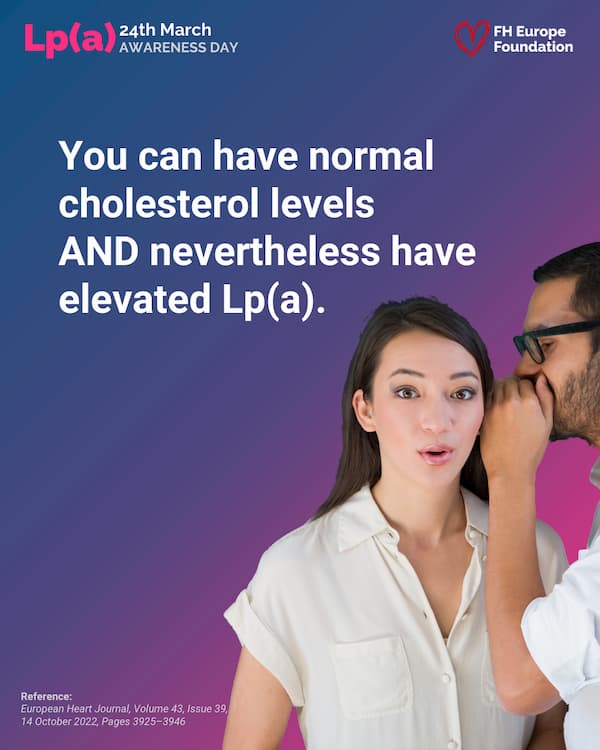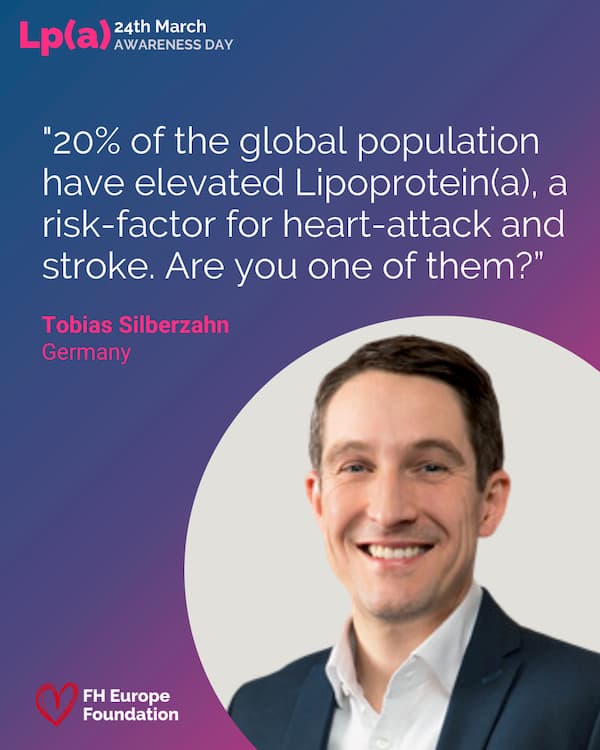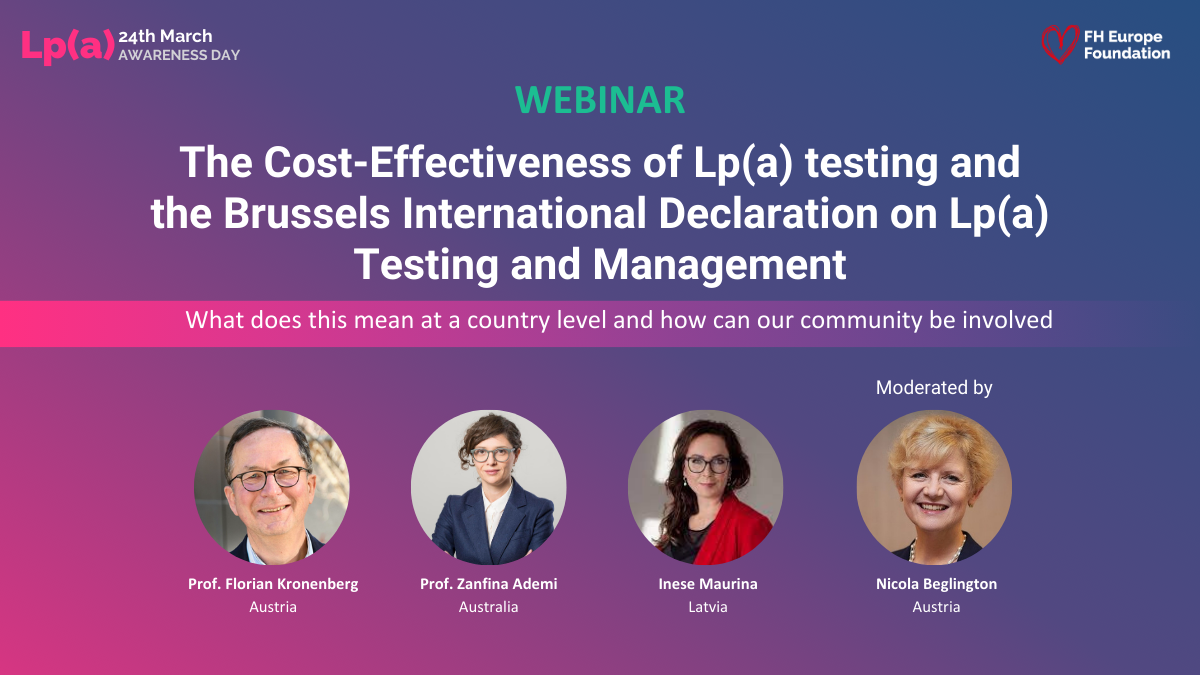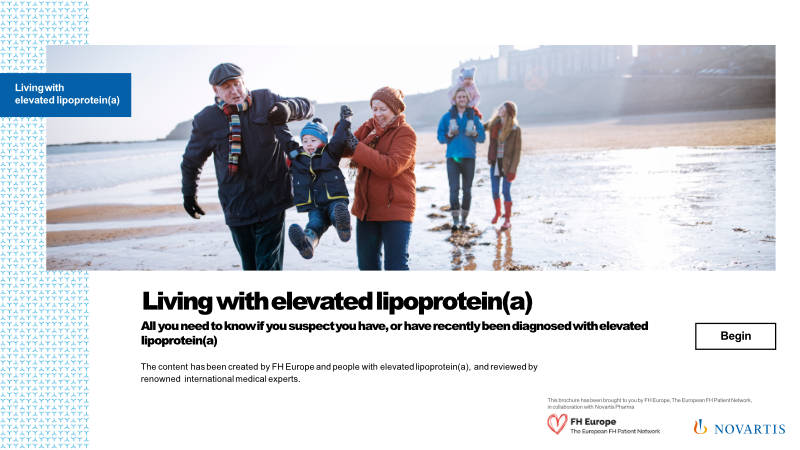
Launched in 2022 to raise awareness of elevated lipoprotein(a), also known as elevated Lp(a) and pronounced: “l-p-little-A”. High Lp(a) concentration is one of the most important causal risk factors for cardiovascular disease (CVD).
At FH Europe Foundation, we use the power of our international patients’ and ambassadors' voices so that everyone understands why they should know about Lp(a) and help you to find whether you have high Lp(a) concentrations. Through our international Network, as well as social media engagement, we will draw attention to this important inherited disorder and encourage everyone to join the movement. And we need your help!
By sharing important information, we can empower all stakeholders to spread the word about high Lp(a) as an under-recognised cause of premature heart disease and stroke. This March we can reach more people at risk for early heart disease and stroke with the third annual Lp(a) Awareness Day. We can make a difference for those who may never have heard of this very common CVD risk factor which runs in families but is undiagnosed in most individuals.


Globally 1 in 5 people are estimated to have elevated levels of Lp(a) which are an independent cardiovascular disease (CVD) risk factor.

This makes an estimated population of 1.4 billion people globally. Despite this, the contribution of elevated Lp(a) concentration to CVD risk remains underappreciated.

Most people have never heard of Lp(a)!

Lp(a) is invisible in the global health policy discourse and plays only a minor role in most medical curricula, if any.


Although medical guidelines exist, there are no policy instruments at international level and very few at national level to support these.


Lipoprotein(a) is also known as Lp(a) for short. It’s passed on in your genes. Lipoprotein(a) is much like LDL cholesterol (sometimes called ‘bad cholesterol’) but is more ‘sticky’. High levels of lipoprotein(a) in your blood can stick to your artery walls and clog them up, leading to heart disease and stroke at a young age.
Lp(a) (pronounced “lipoprotein little a” or “l p little A”) is a lipoprotein rich in cholesterol.
The structure of the Lp(a) particle is very similar to an LDL particle. It differs from LDL as it contains an additional protein, called “apolipoprotein(a)” which acts similarly to a patch of “velcro” on an LDL particle. It is considered a very “sticky” lipoprotein particle because of the function of the added protein. Lp(a) is made in the liver and circulates in the blood just like other lipoproteins.
Many extensive population studies have shown a strong independent relationship between high Lp(a) levels and heart disease. This has led doctors to agree that elevated Lp(a) is a risk factor for cardiovascular disease. It is thought to increase the risk of cardiovascular disease by two different mechanisms:
Like Familial Hypercholesterolaemia (FH), high Lipoprotein(a) is a lipid condition –often referred to as a ‘lipid disorder”, which is genetic and runs in the family but does not require genetic testing to be diagnosed.
Currently, there are no approved treatments for high Lp(a). Yet there are some promising therapies in the pipeline.
Take action and help us raise awareness about this common genetic condition causing early heart disease and stroke.
Below you can find content for Lp(a) Awareness Day 2025, that you can download and share on social media. Help us spread the word also by using the following hashtag when sharing:
Also, don´t forget to tag FH Europe Foundation.

You can also download social media posts in 21 other languages:
Arabic, Chinese, Croatian, Czech, Dutch, French, German, Greek, Hebrew, Hungarian, Italian, Japanese, Latvian, Polish, Portuguese (Brasilian and European), Romanian, Serbian, Slovenian, Spanish and Urdu.
You can also download social media posts in other languages:- German, Hebrew, Hungarian, Italian, Latvian, Polish, Romanian, Slovenian & Spanish. Choose and download the extra languages
You can also download social media posts in other languages:- German, Hebrew, Hungarian, Italian, Latvian, Polish, Romanian, Slovenian & Spanish. Choose and download the extra languages
You can also download social media posts in other languages:- German, Hebrew, Hungarian, Italian, Latvian, Polish, Romanian, Slovenian & Spanish. Choose and download the extra languages
You can also download social media posts in other languages:- German, Hebrew, Hungarian, Italian, Latvian, Polish, Romanian, Slovenian & Spanish. Choose and download the extra languages
On March 31, 2025, from 6–7 PM CET we held a special webinar highlighting key takeaways from the first Lp(a) Global Summit.
We explored groundbreaking findings from FH Europe’s commissioned research on the Cost-Effectiveness of Lp(a) Testing and discussed the impact of the Brussels Declaration. What do these insights mean at the country level, and how can our community take action?
Don’t miss this opportunity to learn and get involved!

Discover the Lp(a) Learning & Support Hub for reliable information and practical resources on elevated Lp(a).
Explore expert webinar recordings, patient stories, key publications, and support materials to better understand and manage your condition. Looking for specialist care?
Use our Find a Specialist tool to connect with a lipid expert near you. Whether you're seeking knowledge or support, this hub provides the tools you need.









Here you can access the European Heart Journal EAS Consensus Paper for Lp(a) which outlines the main guidelines in Europe for elevated Lp(a).
Here you can access a policy publication on how public health recommendations should address Lp(a) measurement: